
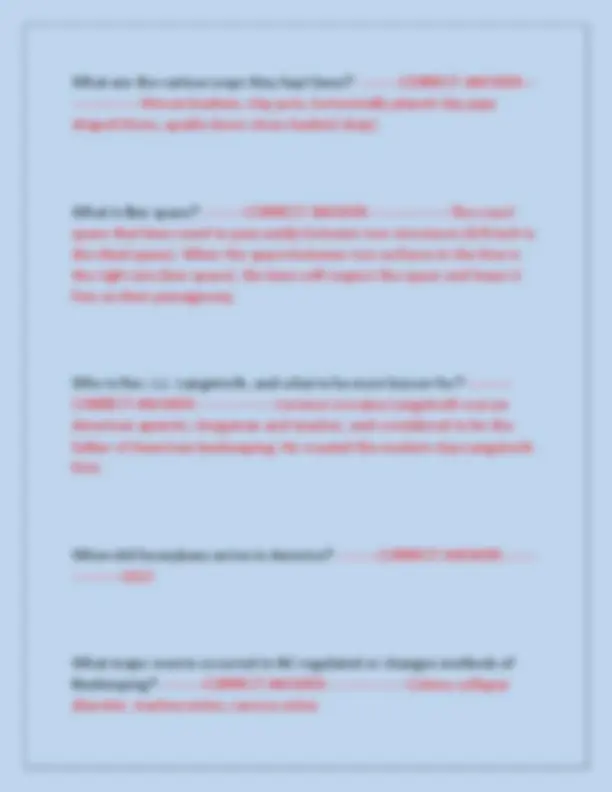
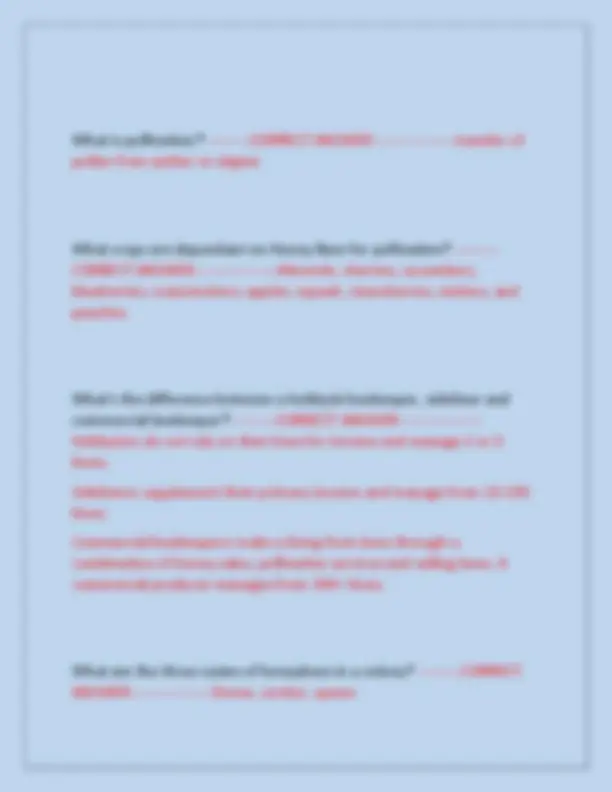
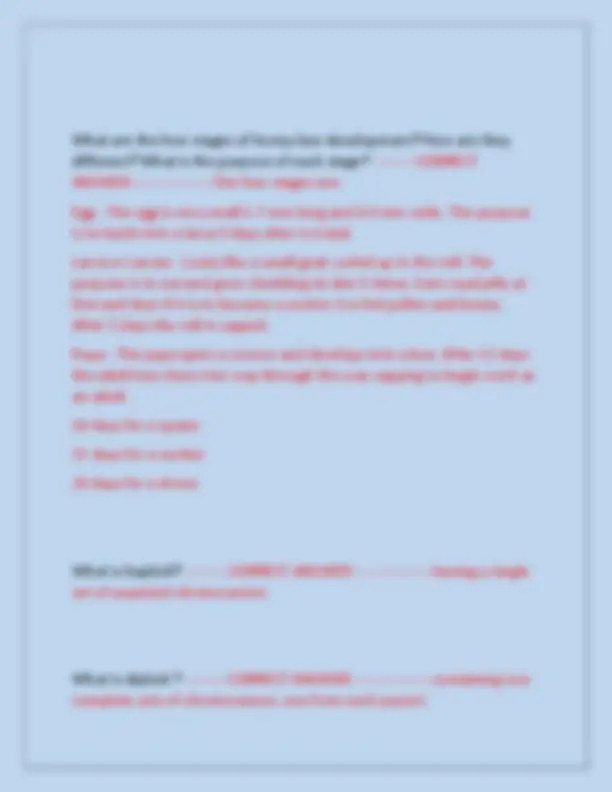
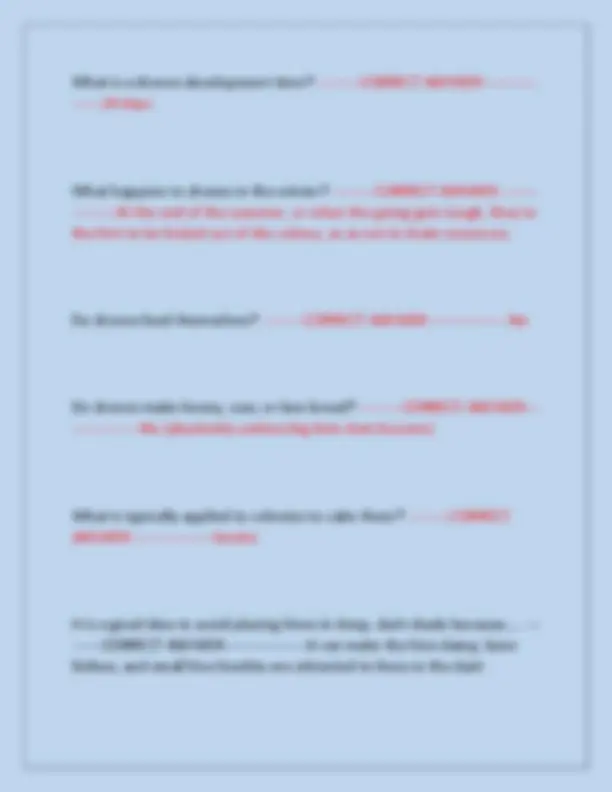
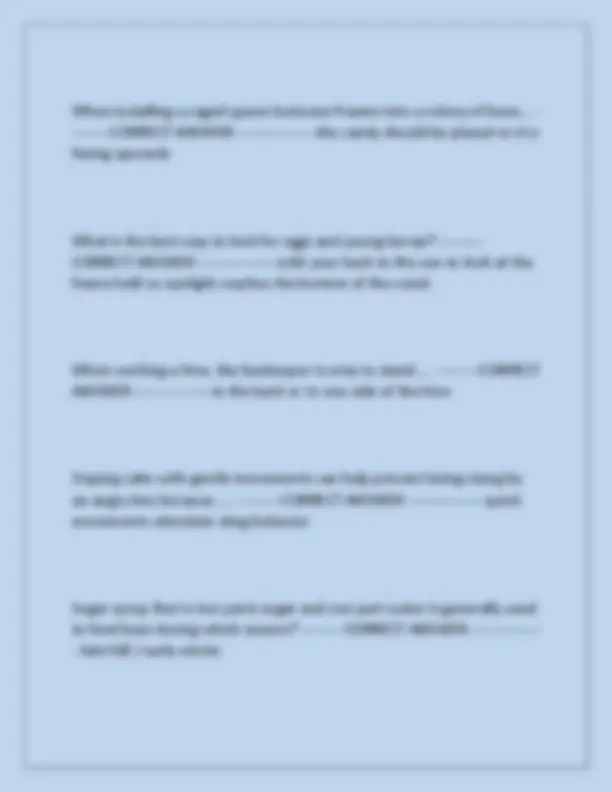
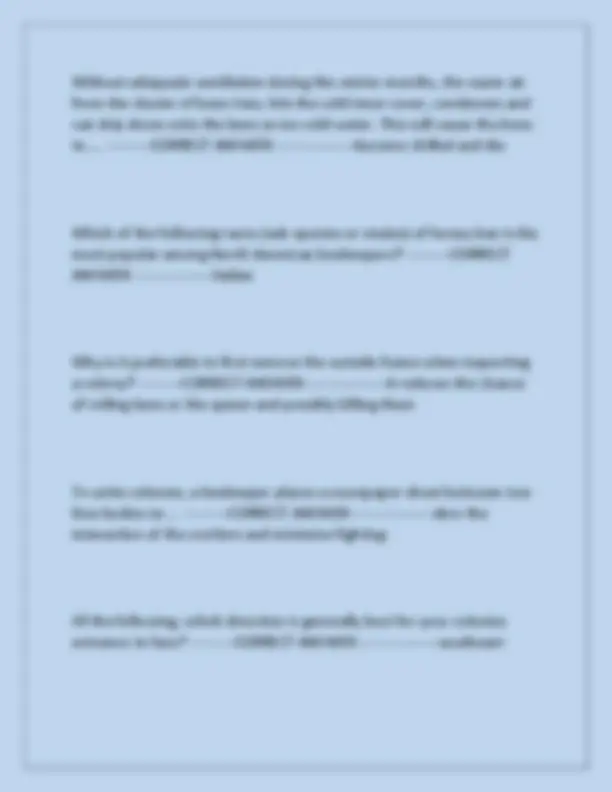
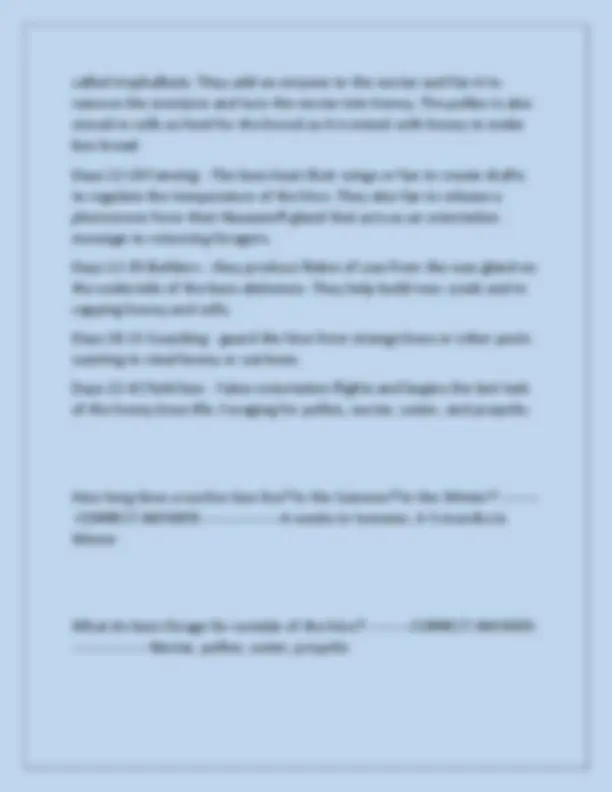
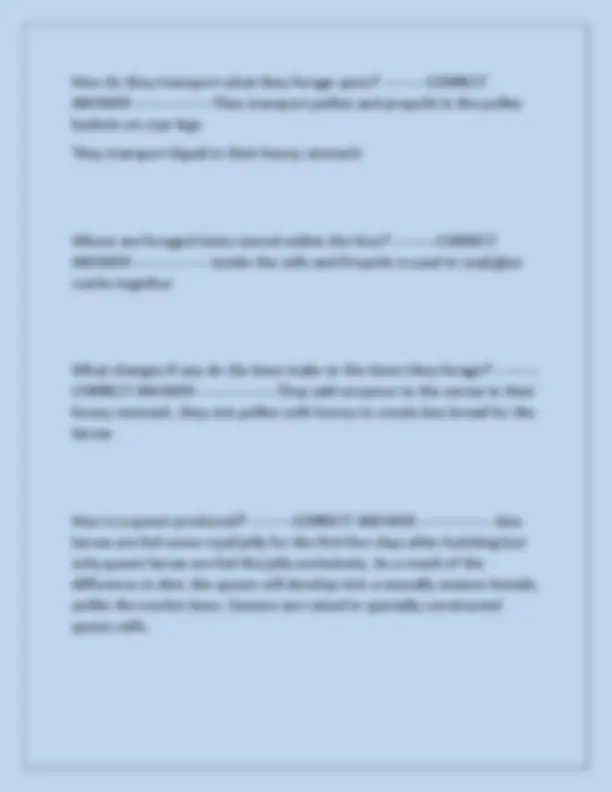
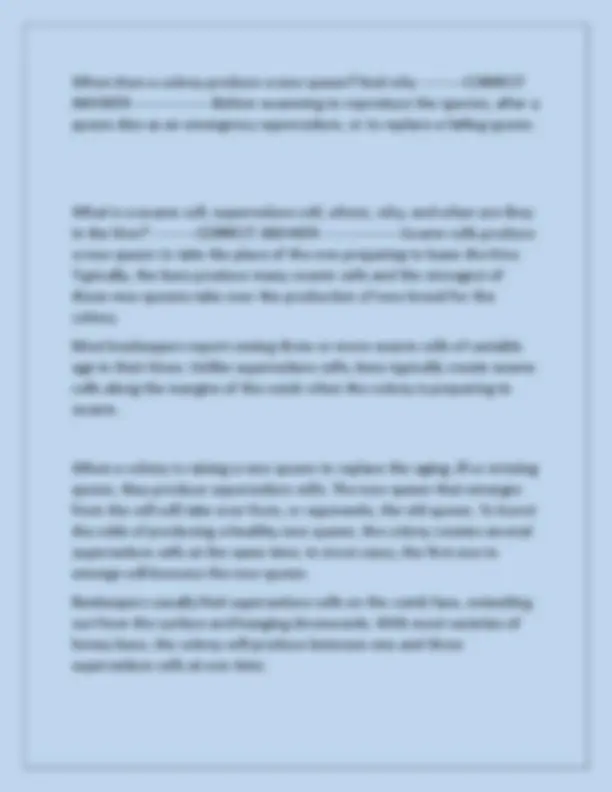
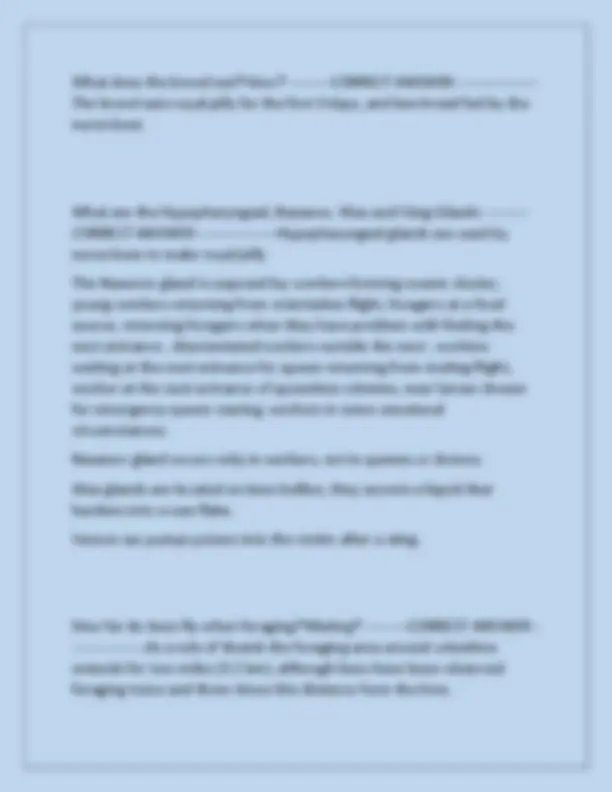
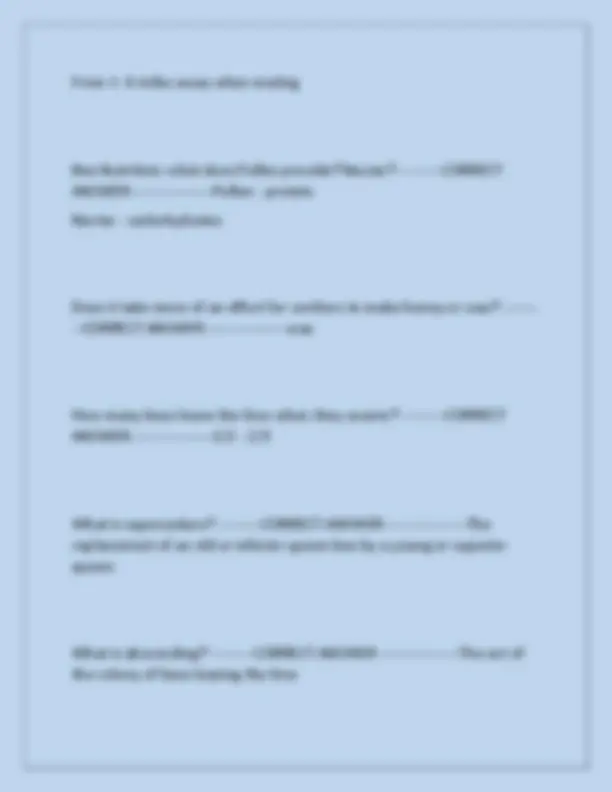
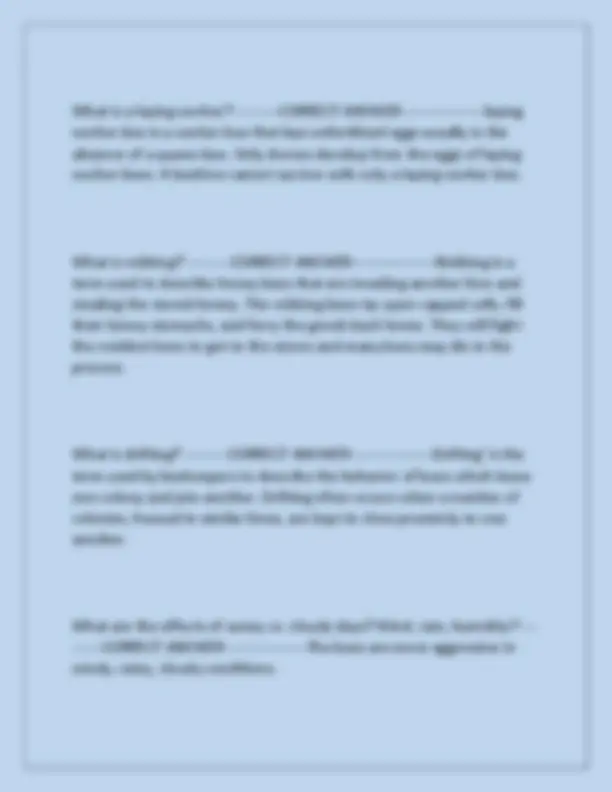
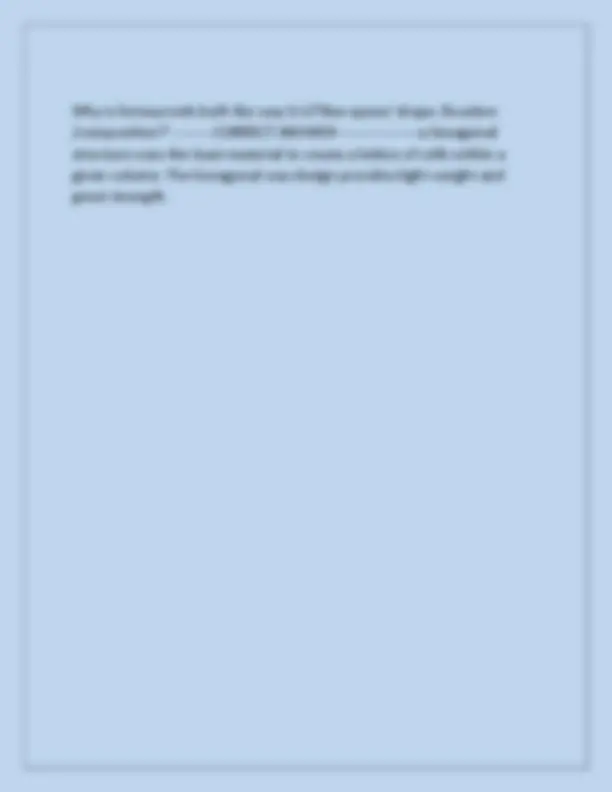


Study with the several resources on Docsity

Earn points by helping other students or get them with a premium plan


Prepare for your exams
Study with the several resources on Docsity

Earn points to download
Earn points by helping other students or get them with a premium plan
Community
Ask the community for help and clear up your study doubts
Discover the best universities in your country according to Docsity users
Free resources
Download our free guides on studying techniques, anxiety management strategies, and thesis advice from Docsity tutors
The EVS 317 Beekeeping Exam 2025 is a comprehensive guide designed for students interested in the field of beekeeping. This document serves as an essential resource for those preparing for examinations in this domain, offering complete questions and verified answers. Students will find this guide invaluable due to its inclusion of accurate and detailed responses, earning a graded A+ rating for its reliability and quality. The exam covers a wide range of topics essential for budding beekeepers. Key areas include the identification of queen swarm cells during hive inspections and understanding the USDA's voluntary honey grade standards, such as the maximum moisture content for Grade A honey, which is 18.6%. The document also delves into different types of honey, notably chunk honey, and the role of propolis, a sticky, resinous material collected by bees.
Typology: Exams
1 / 21

This page cannot be seen from the preview
Don't miss anything!














While doing an inspection, you find a frame that has a lot going on. In the photograph, there are two large cells. What are they? --------- CORRECT ANSWER-----------------queen swarm cells Voluntary U.S. honey grade standards are issued by the USDA under the authority of the Agricultural Marketing Act of 1946. According to these standards, maximum percent moisture content for grade A honey is... -- -------CORRECT ANSWER-----------------18.6% A type of bottled honey consisting of comb honey packaged in a jar surrounded by extracted honey is called.... ---------CORRECT ANSWER---- -------------chunk honey Propolis is... ---------CORRECT ANSWER-----------------a sticky, resinous material that bees collect from trees and plants.
In the US, honey is sold by... ---------CORRECT ANSWER----------------- weight ( in pounds and grams ) What part of honey processing has no effect on its taste? --------- CORRECT ANSWER-----------------Bottling in plastic jars In social insect colonies, the presence of two or more forms which differ morphologically within the same sex is called... ---------CORRECT ANSWER-----------------a caste How long has the NCSBA been in existence? ---------CORRECT ANSWER-- ---------------January 11, 1917 How long has Man been harvesting honey/other products from honeybees? ---------CORRECT ANSWER-----------------The earliest records of humans eating honey (and wax), are believed to date back 10, years
What is pollination? ---------CORRECT ANSWER-----------------transfer of pollen from anther to stigma What crops are dependant on Honey Bees for pollination? --------- CORRECT ANSWER-----------------Almonds, cherries, cucumbers, blueberries, watermelons, apples, squash, strawberries, melons, and peaches. What's the difference between a hobbyist beekeeper, sideliner and commercial beekeeper? ---------CORRECT ANSWER----------------- Hobbyists: do not rely on their bees for income and manage 2 or 3 hives. Sideliners: supplement their primary income and manage from 10- 199 hives Commercial beekeepers: make a living from bees through a combination of honey sales, pollination services and selling bees. A commercial producer manages from 200+ hives. What are the three castes of honeybees in a colony? ---------CORRECT ANSWER-----------------Drone, worker, queen
What are the four stages of honey bee development? How are they different? What is the purpose of each stage? ---------CORRECT ANSWER-----------------The four stages are: Egg - The egg is very small 1.7 mm long and 0.4 mm wide. The purpose is to hatch into a larva 3 days after it is laid. Larva or Larvae - Looks like a small grub curled up in the cell. The purpose is to eat and grow shedding its skin 5 times. Eats royal jelly at first and then if it is to become a worker it is fed pollen and honey. After 5 days the cell is capped. Pupa - The pupa spins a cocoon and develops into a bee. After 12 days the adult bee chews her way through the wax capping to begin work as an adult. 16 days for a queen 21 days for a worker 24 days for a drone What is haploid? ---------CORRECT ANSWER-----------------having a single set of unpaired chromosomes What is diploid? ---------CORRECT ANSWER-----------------containing two complete sets of chromosomes, one from each parent.
other words, the sting is a modified ovipositor that ejects venom instead of eggs. Thus, only female bees can have a stinger. What is the sex of a drone bee? Are they haploid or diploid? --------- CORRECT ANSWER-----------------Male, haploid What is the primary function of Drone bees? ---------CORRECT ANSWER- ----------------To mate with the virgin queen How do they differ in appearance and function from the queen and workers? ---------CORRECT ANSWER-----------------They are the larger than workers, their only function is to eat and make flights to the drone congregation area to mate with a virgin queen. How long do drones live? ---------CORRECT ANSWER-----------------They may live for just a few weeks or up to 4 months. drones die once they mate.
What is a drones development time? ---------CORRECT ANSWER----------- ------24 days What happens to drones in the winter? ---------CORRECT ANSWER-------- ---------At the end of the summer, or when the going gets tough, they're the first to be kicked out of the colony, so as not to drain resources. Do drones feed themselves? ---------CORRECT ANSWER-----------------No Do drones make honey, wax, or bee bread? ---------CORRECT ANSWER--- --------------No (absolutely useless big dum dum buzzers) What is typically applied to colonies to calm them? ---------CORRECT ANSWER-----------------Smoke It is a good idea to avoid placing hives in deep, dark shade because.... --- ------CORRECT ANSWER-----------------it can make the hive damp, bees listless, and small hive beetles are attracted to hives in the dark
Without adequate ventilation during the winter months, the warm air from the cluster of bees rises, hits the cold inner cover, condenses and can drip down onto the bees as ice-cold water. This will cause the bees to.... ---------CORRECT ANSWER-----------------become chilled and die Which of the following races (sub-species or strains) of honey bee is the most popular among North American beekeepers? ---------CORRECT ANSWER-----------------Italian Why is it preferable to first remove the outside frame when inspecting a colony? ---------CORRECT ANSWER-----------------it reduces the chance of rolling bees or the queen and possibly killing them To unite colonies, a beekeeper places a newspaper sheet between two hive bodies to.... ---------CORRECT ANSWER-----------------slow the interaction of the workers and minimize fighting Of the following, which direction is generally best for your colonies entrance to face? ---------CORRECT ANSWER-----------------southeast
Being honey bound refers to... ---------CORRECT ANSWER-----------------a brood nest in which cells are filled with honey to the extent that bees cannot rear brood or enter empty cells to form a contiguous winter cluster. Bee bread is... ---------CORRECT ANSWER-----------------a mixture of pollen and honey used as food by the bees. If your colony loses its queen, the workers' ovaries can begin to produce eggs. From the following choices, which is the most definitive reason to suspect the colony has a laying worker(s)? ---------CORRECT ANSWER-----------------you see cells with two or more eggs Predatory foraging by a stronger colony on the honey stores of a weaker colony is called... ---------CORRECT ANSWER----------------- Robbing The photo was taken on a hot, humid summer evening.What activity is occurring? (huge cluster of bees on the front entrance of a hive) --------- CORRECT ANSWER-----------------The bees are bearding.
called trophallaxis. They add an enzyme to the nectar and fan it to remove the moisture and turn the nectar into honey. The pollen is also stored in cells as food for the brood as it is mixed with honey to make bee bread. Days 12-18 Fanning - The bees beat their wings or fan to create drafts to regulate the temperature of the hive. They also fan to release a pheromone from their Nassanoff gland that acts as an orientation message to returning foragers. Days 12-35 Builders - they produce flakes of wax from the wax gland on the underside of the bees abdomen. They help build new comb and in capping honey and cells. Days 18-21 Guarding - guard the hive from strange bees or other pests wanting to steal honey or eat bees. Days 22-42 field bee - Takes orientation flights and begins the last task of the honey bees life. Foraging for pollen, nectar, water, and propolis. How long does a worker bee live? In the Summer? In the Winter? --------
How do they transport what they forage upon? ---------CORRECT ANSWER-----------------They transport pollen and propolis in the pollen baskets on rear legs They transport liquid in their honey stomach Where are foraged items stored within the hive? ---------CORRECT ANSWER-----------------Inside the cells and Propolis is used to seal/glue cracks together What changes if any do the bees make to the items they forage? --------- CORRECT ANSWER-----------------They add enzymes to the nectar in their honey stomach, they mix pollen with honey to create bee bread for the larvae How is a queen produced? ---------CORRECT ANSWER-----------------bee larvae are fed some royal jelly for the first few days after hatching but only queen larvae are fed the jelly exclusively. As a result of the difference in diet, the queen will develop into a sexually mature female, unlike the worker bees. Queens are raised in specially constructed queen cells.
What is the approximate life length of a queen? ---------CORRECT ANSWER-----------------average lifespan of a queen is three to four years Approximately how many eggs does a queen lay a day ?( during brood build up) ---------CORRECT ANSWER----------------- 1500 What is meant by Brood? ---------CORRECT ANSWER-----------------In beekeeping, bee brood or brood refers to the eggs, larvae and pupae of honeybees. Where is brood generally found in the hive? ---------CORRECT ANSWER-- ---------------In modern removable frame hives the nursery area is in the brood chamber, which beekeepers prefer to be in the bottom box. What does healthy larve look like? ---------CORRECT ANSWER--------------- --curled white grubs found in open cells of brood combs. Larvae are glistening and pearly white, with an orange gut line running along their back.
What are the three stages of development prior to emerging as an adult bee? ---------CORRECT ANSWER-----------------Egg, larva, pupa How does a brood cell become capped? ---------CORRECT ANSWER-------- ---------Adult bees cap these cells once the brood has gone through the process of egg and larvae. Once the cell is capped, the larvae spins its own cocoon while inside the cell and develops into a pupae How does the covering of brood cells differ from the covering on honey or pollen cells? ---------CORRECT ANSWER-----------------Capped honey cells are slightly indented versus the capped worker brood cells that have a slight protrusion to them. Pollen is not capped. Why? ---------CORRECT ANSWER-----------------The protrusion gives the pupa extra room to grow. Composition (color) of brood and honey? ---------CORRECT ANSWER------ -----------Waxed, brood usually cream to brown colored, honey is white.
From 1- 6 miles away when mating Bee Nutrition: what does Pollen provide? Nectar? ---------CORRECT ANSWER-----------------Pollen - protein Nectar - carbohydrates Does it take more of an effort for workers to make honey or wax? ------- --CORRECT ANSWER-----------------wax How many bees leave the hive when they swarm? ---------CORRECT ANSWER-----------------1/2 - 2/ What is supersedure? ---------CORRECT ANSWER-----------------The replacement of an old or inferior queen bee by a young or superior queen. What is absconding? ---------CORRECT ANSWER-----------------The act of the colony of bees leaving the hive
What is a laying worker? ---------CORRECT ANSWER-----------------laying worker bee is a worker bee that lays unfertilized eggs usually in the absence of a queen bee. Only drones develop from the eggs of laying worker bees. A beehive cannot survive with only a laying worker bee. What is robbing? ---------CORRECT ANSWER-----------------Robbing is a term used to describe honey bees that are invading another hive and stealing the stored honey. The robbing bees rip open capped cells, fill their honey stomachs, and ferry the goods back home. They will fight the resident bees to get to the stores and many bees may die in the process. What is drifting? ---------CORRECT ANSWER-----------------Drifting' is the term used by beekeepers to describe the behavior of bees which leave one colony and join another. Drifting often occurs when a number of colonies, housed in similar hives, are kept in close proximity to one another. What are the effects of sunny vs. cloudy days? Wind, rain, humidity? --- ------CORRECT ANSWER-----------------The bees are more aggressive in windy, rainy, cloudy conditions.